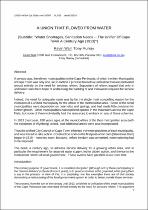 ResearchSpace
ResearchSpace
A union that flowed from water: "Water shortages, sanitation needs -- The unifier of Cape Town a century ago (1913)"
JavaScript is disabled for your browser. Some features of this site may not work without it.
- ResearchSpace
- →
- Research Publications/Outputs
- →
- Conference Publications
- →
- View Item
| dc.contributor.author |
Wall, K

|
|
| dc.contributor.author |
Murray, T

|
|
| dc.date.accessioned | 2013-06-12T12:43:45Z | |
| dc.date.available | 2013-06-12T12:43:45Z | |
| dc.date.issued | 2012-05 | |
| dc.identifier.citation | Wall, K and Murray, T. 2012. A union that flowed from water: "Water shortages, sanitation needs -- The unifier of Cape Town a century ago (1913)" In: WISA 2012 Biennial Conference & Exhibition, Cape Town, 6-10 May 2012 | en_US |
| dc.identifier.uri | http://hdl.handle.net/10204/6776 | |
| dc.description | WISA 2012 Biennial Conference & Exhibition, Cape Town, 6-10 May 2012 | en_US |
| dc.description.abstract | A century ago, the eleven municipalities in the Cape Peninsula, of which the then Municipality of Cape Town was only one, set in motion a process towards a unification that was motivated almost entirely by the need for services reform. Supporters of reform argued that only in unification was there hope of addressing the backlog of and innovation required for service delivery. Indeed, the need for adequate water was by far the single most compelling reason for the institution of a unified municipality for the whole of the metropolitan area. Some of the small municipalities were dependent on boreholes and springs, and had made little provision for further growth. Other municipalities had explored options in the mountains across the Cape Flats, but none of them individually had the resources to embark on any of these schemes. In 1913 (next year, 100 years ago), all the municipalities of the then metropolitan area (with the exception of Wynberg) united, and additional areas were also incorporated. Thus the unified City Council of Cape Town inherited the water problems of each municipality, and was forced to take action. Construction work on the first post-union dam (Steenbras Dam) began in 1918 -- none too soon, because, before the dam was completed, water rationing had to be imposed. The need, a century ago, to address service delivery for a growing urban area, and in particular the requirement for assured water supply, led to citizen action, and thence to the institutional reform of local government. These events have parallels in our own time. | en_US |
| dc.language.iso | en | en_US |
| dc.publisher | WISA 2012 Conference | en_US |
| dc.relation.ispartofseries | Workflow;10173 | |
| dc.subject | Cape Town municipality | en_US |
| dc.subject | City Council of Cape Town | en_US |
| dc.subject | Water shortages | en_US |
| dc.subject | Sanitation needs | en_US |
| dc.title | A union that flowed from water: "Water shortages, sanitation needs -- The unifier of Cape Town a century ago (1913)" | en_US |
| dc.type | Conference Presentation | en_US |
| dc.identifier.apacitation | Wall, K., & Murray, T. (2012). A union that flowed from water: "Water shortages, sanitation needs -- The unifier of Cape Town a century ago (1913)". WISA 2012 Conference. http://hdl.handle.net/10204/6776 | en_ZA |
| dc.identifier.chicagocitation | Wall, K, and T Murray. "A union that flowed from water: "Water shortages, sanitation needs -- The unifier of Cape Town a century ago (1913)"." (2012): http://hdl.handle.net/10204/6776 | en_ZA |
| dc.identifier.vancouvercitation | Wall K, Murray T, A union that flowed from water: "Water shortages, sanitation needs -- The unifier of Cape Town a century ago (1913)"; WISA 2012 Conference; 2012. http://hdl.handle.net/10204/6776 . | en_ZA |
| dc.identifier.ris | TY - Conference Presentation AU - Wall, K AU - Murray, T AB - A century ago, the eleven municipalities in the Cape Peninsula, of which the then Municipality of Cape Town was only one, set in motion a process towards a unification that was motivated almost entirely by the need for services reform. Supporters of reform argued that only in unification was there hope of addressing the backlog of and innovation required for service delivery. Indeed, the need for adequate water was by far the single most compelling reason for the institution of a unified municipality for the whole of the metropolitan area. Some of the small municipalities were dependent on boreholes and springs, and had made little provision for further growth. Other municipalities had explored options in the mountains across the Cape Flats, but none of them individually had the resources to embark on any of these schemes. In 1913 (next year, 100 years ago), all the municipalities of the then metropolitan area (with the exception of Wynberg) united, and additional areas were also incorporated. Thus the unified City Council of Cape Town inherited the water problems of each municipality, and was forced to take action. Construction work on the first post-union dam (Steenbras Dam) began in 1918 -- none too soon, because, before the dam was completed, water rationing had to be imposed. The need, a century ago, to address service delivery for a growing urban area, and in particular the requirement for assured water supply, led to citizen action, and thence to the institutional reform of local government. These events have parallels in our own time. DA - 2012-05 DB - ResearchSpace DP - CSIR KW - Cape Town municipality KW - City Council of Cape Town KW - Water shortages KW - Sanitation needs LK - https://researchspace.csir.co.za PY - 2012 T1 - A union that flowed from water: "Water shortages, sanitation needs -- The unifier of Cape Town a century ago (1913)" TI - A union that flowed from water: "Water shortages, sanitation needs -- The unifier of Cape Town a century ago (1913)" UR - http://hdl.handle.net/10204/6776 ER - | en_ZA |





